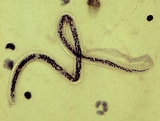
Wuchereria bancrofti
Overview
Filaria, is a parasitic filarial
nematode
(roundworm) spread by a mosquito
vector. It is one of the three parasites that cause lymphatic filariasis, an infection of the lymphatic system by filarial worms. It affects over 120 million people, primarily in Africa, South America, and other tropical and sub-tropical countries. If the infection is left untreated it can develop into a chronic disease called elephantiasis
.
Filariasis
Filariasis is a parasitic disease and is considered an infectious tropical disease, that is caused by thread-like nematodes belonging to the superfamily Filarioidea, also known as "filariae"....
nematode
Nematode
The nematodes or roundworms are the most diverse phylum of pseudocoelomates, and one of the most diverse of all animals. Nematode species are very difficult to distinguish; over 28,000 have been described, of which over 16,000 are parasitic. It has been estimated that the total number of nematode...
(roundworm) spread by a mosquito
Mosquito
Mosquitoes are members of a family of nematocerid flies: the Culicidae . The word Mosquito is from the Spanish and Portuguese for little fly...
vector. It is one of the three parasites that cause lymphatic filariasis, an infection of the lymphatic system by filarial worms. It affects over 120 million people, primarily in Africa, South America, and other tropical and sub-tropical countries. If the infection is left untreated it can develop into a chronic disease called elephantiasis
Elephantiasis
Elephantiasis is a disease that is characterized by the thickening of the skin and underlying tissues, especially in the legs and male genitals. In some cases the disease can cause certain body parts, such as the scrotum, to swell to the size of a softball or basketball. It is caused by...
.
Unanswered Questions

